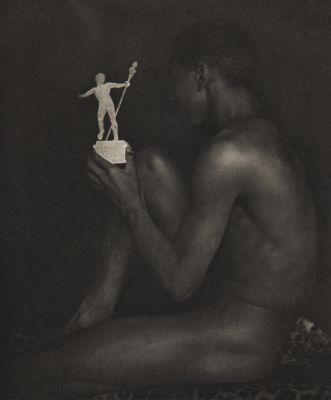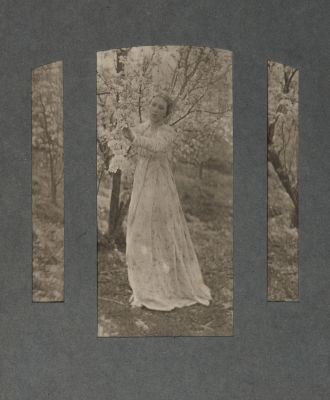
Title
Vesper BellsArtist
Eickemeyer, Rudolf (American, 1862 - 1932)Publication
American Pictorial Photography, Series OneDate
1900Process
PhotogravureAtelier
Photochrome Engraving Company, New YorkImage Size
19 x 14.7 cmSheet Size
38 x 28 cm
Originally taken in 1894, the subject of this photograph is the grandmother of the photographer Rudolf Eickemeyer Jr., who endured a month of sittings in a dairy barn on her farm outside of Yonkers, New York before Eickemeyer was satisfied with the final result. The photographs made at this sitting were the subject of a five-page essay – “How a Picture Was Made”, in the third issue of Camera Notes (January, 1898; pp. 63 – 66).
“How a Picture Was Made,” revealed the painstaking revisions he made to create a deceptively simple portrait of his grandmother, “Vesper Bell.” This five page essay described the long complex interaction between photographer and subject mediated by the camera. Eickemeyer deliberately destroyed the notion that the process was automatic, unplanned, or mechanical. Narrative meaning was strengthened by changing the old woman’s activity from simple devotion to a homely scene of chores interrupted for prayer. Added props and adjusted light improved the composition. Each modification required a new print and planning. “Vesper Bell” went on to win medals in London, Calcutta, and Vienna.” (PhotoSeed.com)
As head of the Camera Notes publication committee, Stieglitz issued a limited edition of 150 portfolios in the fall of 1899 to "exemplify the most characteristic examples of the work of those Americans whose names are best known to the club or whose influence has been most pronounced on the development of pictorial photography in America.” Additional works were to be added to the portfolio over time so that ultimately the complete series would be the most “representative collection of pictures ever published, and should be in the hand of every serious student of pictorial photography, not alone as a record of representative American work, but because of the exceptional opportunity afforded by it of perfecting one’s own work through the careful, conscientious study of that or others.” The portfolio, American Pictorial Photography, featured eighteen photogravures printed on Indian paper (including Stieglitz’s Reflections Venice and Early Morn), along with a title page and table of contents printed in red and black on Japanese paper, all enclosed within green cloth covers stamped in gold with the seal of the Camera Club. The name of the subscriber and the number of the copy printed on the reverse of the title page, and each copy was counter-signed by Stieglitz. Arranged, engraved, and printed by the Photochrome Engraving Company, the photogravures were “so remarkably executed as to deceive the eye into the belief that they are original platinum and carbon prints and not merely reproductions therefrom. The engravers have every reason to feel proud of their work, which has attracted great attention wherever shown, and which deserves to be ranked with, if not as, the best work of the kind ever done in this country.” Greenough p. 938
This print is from the American Pictorial Photography, Series One portfolio.
References
Greenough, Sarah, and Alfred Stieglitz. Alfred Stieglitz: The Key Set : the Alfred Stieglitz Collection of Photographs. Washington, D.C: National Gallery of Art; New York: Harry N. Abrams, 2002



